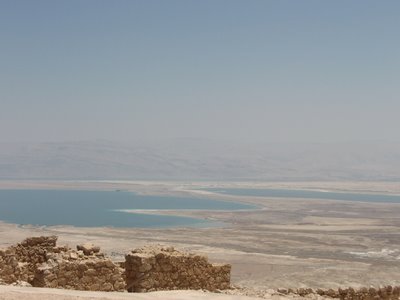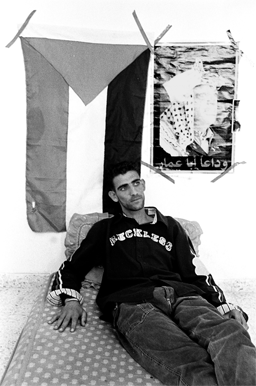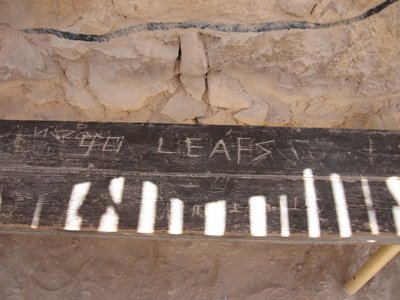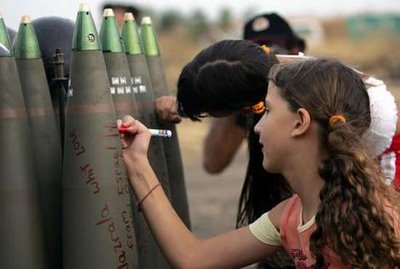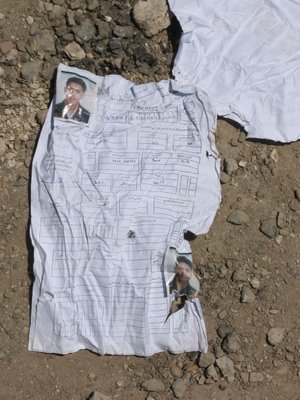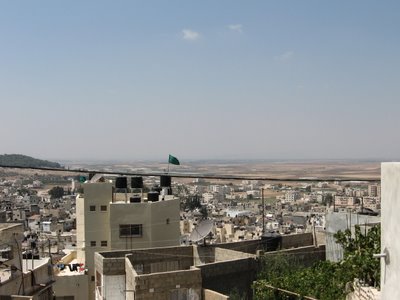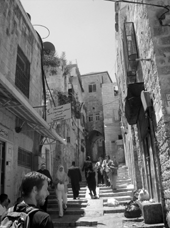
I did something dumb. Totally dumb.
Abu Majnoon, Abu al-Jundee (These are the made up nicknames each of us have here) and I went to Hebron this morning and I forgot to bring my passport. We were in a servees (a shared, 8 person taxi) about to leave Ramallah when I realized my mistake. I had emptied my bag the night before and I forgot to put it back in. Stupid! I was panicking and A.M., in the front seat, told our driver who insisted that it wouldn't be a big problem. He was right in that it turned out not to be a BIG problem, but it was definitely a pain in the ass.
We were off. I was in the back of the van with two Palestinian teenagers... Tariq and Ali who were, I'm guessing 17. Servees are good ways to interact with random people and Palestinians, being by far the most engaging and generous people I've met (I'm not saying that my interactions are always perfect!) anywhere in the world. Usually I will be asked the standard: "what's your name", "where are you from", and then I'll be asked if I'd like to come to their village or town and visit with them, or go to someone's wedding. It's quite amazing.
As we approached the dreaded Qalandia (which, fortunately we were not going to have to go through) we passed a number of Humvees and Jeeps moving in the opposite direction. Tariq turned to me and asked where I was from. I told him Canada. Then he asked if I loved Israel. I made sure I understood his question (my Arabic isn't always good at helping me get nuance) and responded by saying "No I don't love Israel". His response didn't catch me as off guard as it would have a month ago. He told me that it was good that I didn't love Israel: An Israeli soldier murdered his sister.
He was from Tulkarm, a town in the north-west of the Occupied Territories, a town skirting the "separation Wall". Our conversation sort of ended shortly thereafter as the woman in front of me, as we approached the first checkpoint passed her infant son towards us. I quickly found that the plan was to put him in the baby carrier that was at my feet. As the baby lay at my feet, clutching and rubbing my middle finger, Tariq leaned over and asked if I'd close the blind beside me: we were approaching the checkpoint. That was the first sign of trouble.
The soldier spoke with the driver who then motioned back to us. Ali handed his green ID up to the driver who showed it to the soldier. Tariq was leaning back, trying to hide himself as best he could behind my shoulder. The soldier looked at the ID and we were waved through - it was a "flying" or temporary checkpoint set up indiscriminately at Israeli will. About a half hour later the baby was asleep at my feet and I was amazed that he could doze through the rugged West Bank roads replete with quick starts and sudden stops. We got to the permanent checkpoint half way through our trip, not far from the town of Abu Dees where this time we were stopped. The soldier opened up the sliding side door and took a look at us in the back. He asked for Tariq and Ali's ID and walked off. We sat there for fifteen minutes before the driver stepped out and went into the checkpoint hut. He spoke some Hebrew (likely a skill learned in Israeli jails... typical of former inmates) and was handed the boys ID's back. And we were off again. So far, no soldier has asked for MY ID... which in this case was a Provincial Drivers license. I cursed myself again and then knocked on wood.
An hour later we were driving through Gush Etzion Settlement Bloc. One of the larger Settlement Blocs, Gush Etzion was also known to be one of the more militant. We drove along the street and all of a sudden we come to a traffic light with Israeli teenagers and soldiers (both heavily armed) crossing the road... Like nothing out of the ordinary... except that they are in the middle of the West Bank surrounded by people whose land they had stolen and who do not want them there: a theme I would be reminded of later in the day.
We continued on for about a Kilometer before we came to another flying checkpoint where were stopped again. This time, an older soldier slid the side door open and asked for everyone's ID (except the women). I thought I was bucked. The worst case scenario, I reasoned, was that they would detain me while I sent A.M. back to the apartment to fetch my Passport and Visa. That would be the worst case scenario. I should have known though, that as much as the IDF do not want Westerners in the West Bank so that they can continue to do what they do without outsiders knowing, they wouldn't bother to hold me. No, today, as everyday, they were after young Palestinian Men. I remember reading in Amira Hass's book "Drinking the Sea at Gaza" that if you were a young man living in Gaza you had no hope of getting a work visa to provide for your family. They would only issue work visas to those over 40 and married. She said that Palestinian youths in Gaza were just "waiting to turn 40".
I showed the soldier my drivers license and tried to explain myself - "how will I see your visa" he asked derisively. I shook my head in resignation. He handed the ID back and I knew that it didn't matter. Ali and Tariq were taken out of the servees and lined up with the other group of young men, obviously removed from other taxis. We pulled over to the side of the road and with an ominous move, our driver turned off the car.
We waited there for a while. I looked back out the window a few times to see the soldiers speaking with Tariq. Eventually Ali came back over to the cab with another young man. They spoke with the driver and Ali got back in. A few minutes later though Ali was back out of the cab and the other boy was in his place, beside me in the back. Our driver got out, made his way over to the Jeep where Tariq was standing and spoke with the soldier there. I saw Tariq give the driver some money and then he was spun around by the soldier and frisked against the side of the jeep. They bent his arm back and I saw him grimace as they felt up and down his legs. As they were doing this, our driver got back in and we began to move on.
We came into Hebron quite quickly. I hadn't realized that we had been just outside when we were stopped for the last time. Hebron is quite large - in fact it's the biggest city (with all the surrounding towns) in the West Bank - and it took us a while to make it into the center of town. When we got there, A.M. asked our driver how to get into the old city and he directed us to take another (private cab). We did and after a short drive (it turns out we could have walked it - we in fact left the Old City and wound up in the center of town by accident) we were let out at the end of a dead end street. At a set of closed turnstiles, a friendly woman directed us to go around and she lead us the hundred yards to the right alley.
We walked along until we came to a set of turnstiles. We waited for a local to go through them (we're always a little hesitant to walk through turnstiles unless told to do so by a local or the IDF) before following him through. At the other end, behind cement barricades the IDF soldier there asked for our passports. I go through the same routine... this time telling him that I left it in my hotel room in Bethlehem (passing as a Christian tourist and not a West Bank resident). He lets me go through. On the other end is a road with a fence running alongside it. Twenty feet to the left are another set of turnstiles and metal detectors and I guess right that its the entrance to the Ibrihimi Mosque and the Tombs of the Patriarchs.

We approached the metal detectors apprehensively. A handful of soldiers stood around staring at us. A jovial looking Israeli policeman stood forward and told us that it was prayer time and that we could not go in (same routine I went through at the Temple Mount in Jerusalem). We tell him we'll come back and we turn around and walk past the checkpoint that we came through. Half way along the road I start to see posters plastered all over the place with the smiling face of Meir Kahane. Kahane was an American Jew who started a movement in the US called the Jewish Defense League and one in Israel called "Kach" which was eventually outlawed in Israel because of its violent ideology that advocated the (forced) expulsion of Arabs from historic Israel (which to some Kahanists includes the Sinai, Jordan, Lebanon, and parts of Syria and Iraq) and the establishment of a Jewish theocracy. Kahane was assassinated in New York after he was deported from Israel. But the ideology he created survives, especially amongst the militant settlers in Hebron.
And Baruch Goldstein was a Kahanist.
On February 25 1994, Goldstein, dressed in his Israeli Army uniform, walked into the Ibrihimi Mosque and opened fire with an automatic weapon upon praying Muslims. He killed 29 and wounded 125+. In the riots that followed throughout Israel and the Occupied Territories, another 30 Arabs were killed by the IDF while 4 settlers were killed by Arabs. Goldstein was an American from New York, who like so many other Americans, settled in the militant Settlements that are in and surround Hebron. The memory of Goldstein was present as I walked down that street in front of the Mosque where he killed so many and seeing his ideologue on a poster sent chills down my spine.
At the end of the street (50 feet) we came to the third checkpoint in less than 100 meters. There another soldier examined my drivers license and let me go. Before we knew it, we had walked into the Jewish Settlement in the Old City. I tensed up. We walked another thirty feet to an opening that looked up towards the mosque. We cautiously took out our cameras and snapped a few shots before we decided that we had had enough.
We went back through the checkpoint and back towards the entrance to the Mosque. The jovial policeman there stood in front of us and made small talk. Where are we from? What were we doing in Hebron? What did we do back home? A.J. a former Marine who works as a sous chef told him he cooked and the Policeman explained that he too was a chef. The Car-15 assault rifle around his neck and the pistol in his waist band told me otherwise. ("why aren't you in a kitchen then?!!?" I thought).
After fifteen minutes of waiting, watching the teenage Israeli soldiers talk on their cell phones with their boyfriends and girlfriends we were allowed in.
We walked through the metal detectors and had our bags searched. Once through we walked uptowards the Mosque, through a gate and not twenty feet later another pair of Israeli soldiers and metal detectors. Nonchalantly the teenager soldier looks through my bag; "Anything sharp?" - "No" - "Any knives?" - "No" - "Any guns?" - "No"- "Want one?". I was caught off guard. I hope he was joking.
The Mosque itself was unimpressive for A.M. who has been to three of arguably the most beautiful mosques in the world (al-Azhar in Cairo and Umayyad Mosque in Damsacus... Suleiman Mosque in Istanbul is also on that list) but I was impressed. The tombs of the patriarchs weren't what I was expecting. They are outside of the ground, in what look like large household oil containers - but covered in fabric and enclosed in a brick and barred cube. Issac and Rebecca's tombs (they're separate) are entirely within the Mosque, while Abraham's and Sarah are awkwardly placed against the walls - which apparently connects with the synagogue next door.
We walked around the Mosque some more and then made our way outside and back through the metal detectors. As we approach the last metal detectors two teenage boy-soldiers were playing monkey in the middle with the beret of a teenage-girl soldier. Their assault rifles, slung around their backs bounced up and down as they jumped around and I didn't know whether to laugh or cry.
AM told us that he wanted to try and walk around the main road of the Jewish Settlement. Two votes to one and we made our way back to the Arab quarter. Walking along one of the main alleys of the Old City we passby store after store that are shuttered up. One of the locals who was walking beside us explained that they've been closed for 15 years.
At one point we come to the spot that I had been dreading. Above our heads, chicken wire had been installed running the length of the street (Old City Streets in the Middle East are no more than twenty feet wide). Through the trash that had piled up on the wire I saw a half dozen little Israeli flags and one large one.
Because of those tombs that are in the Mosque, the Jewish tradition holds Heron as a very venerated place. After Israel began occupying The Werst Bank in 1967 an infl;ux of Jewish Settlers moved in around the city in a complex of settlements - all illegal under International Law - called Qyriat Arba. At some point Jewish Settlers established a foothold inside the Old City of Hebron. There, the most militant of the Settler Movement squatted in Palestinian homes when the occupants were out in at their jobs and refused to leave when they retuned. The Israelis, (most notably under Sharon) refused to evict them and instead sent in the IDF to protect the squatters. Now, the ratio is apparently 500 Settlers and 1500 Soldiers in Hebron. The Settlers, believing that Hebron (and all of the West Bank... and according to Kach... half of the Middle East) should be lived in by only Jews, began a campaign of hate crimes against the Arab Palestinian population. The Chicken wire was meant to protect the Palestinians in the Old City from the garbage and feces that are thrown out of the windows by the Settlers unto the Arabs in the streets below. I had known that this happens, but seeing it was emotional.
Outside of the Old City, we ate and made our way back home. Again, not having my passport was a problem, but not as much as it was on our way in. This time the cab was carrying two older couples who never attract attention from the IDF - we were waived through most of the checkpoints. Crammed into the back of the cab for the two and a half drive of just 60km I wondered where Tariq and Ali were now. The murder of Tariq's sister by the IDF, in a cruel twist actually puts him on a list that heavily restricts his movements. It seems that the Israelis believe that the families of murdered love-ones have no love for the Israeli military. The logic is that the death will be avenged in some way... shooting... suicide bomb. The murder of Tariq's sister made Tariq's life that much more tough. It seems that he didn't have a good enough reason to go from Tulkarm in the north to Hebron in the south.
Friends in Hebron? Family in Hebron? School in Hebron? Within his own country Tariq isn't allowed too far from home (80km). Israel has shit-throwing settlers to protect.
***
Pictures:
Ibrihimi Mosque and the Tombs of the Patriarchs - With Israeli Flag
Settler trash and chicken wire in the Old City - Also with Israeli Flags

